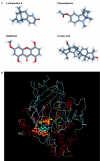Natural products and drug discovery. Can thousands of years of ancient medical knowledge lead us to new and powerful drug combinations in the fight against cancer and dementia?
- PMID: 19229284
- PMCID: PMC2658564
- DOI: 10.1038/embor.2009.12
Natural products and drug discovery. Can thousands of years of ancient medical knowledge lead us to new and powerful drug combinations in the fight against cancer and dementia?
Figures






References
-
- Aggarwal BB, Shishodia S (2006) Molecular targets of dietary agents for prevention and therapy of cancer. Biochem Pharmacol 71: 1397–1421 - PubMed
-
- Akao T, Yoshino T, Kobashi K, Hattori M (2002) Evaluation of salicin as an antipyretic prodrug that does not cause gastric injury. Planta Med 68: 714–718 - PubMed
-
- Baker DD, Chu M, Oza U, Rajgarhia V (2007) The value of natural products to future pharmaceutical discovery. Nat Prod Rep 24: 1225–1244 - PubMed
-
- Beghyn T, Deprez-Poulain R, Willand N, Folleas B, Deprez B (2008) Natural compounds: leads or ideas? Bioinspired molecules for drug discovery. Chem Biol Drug Des 72: 3–15 - PubMed
Publication types
MeSH terms
Substances
LinkOut - more resources
Full Text Sources
Other Literature Sources
Medical

